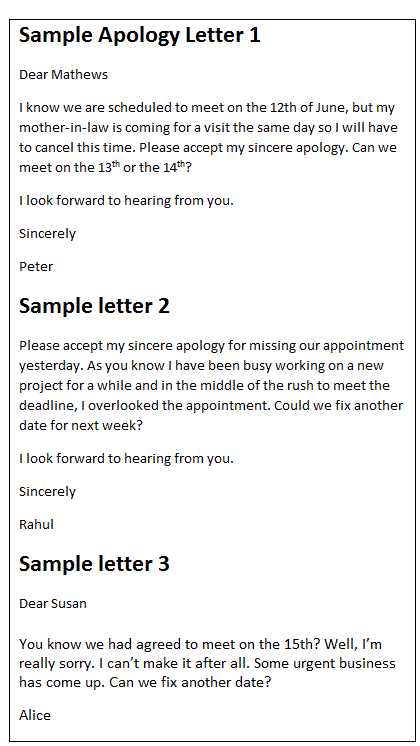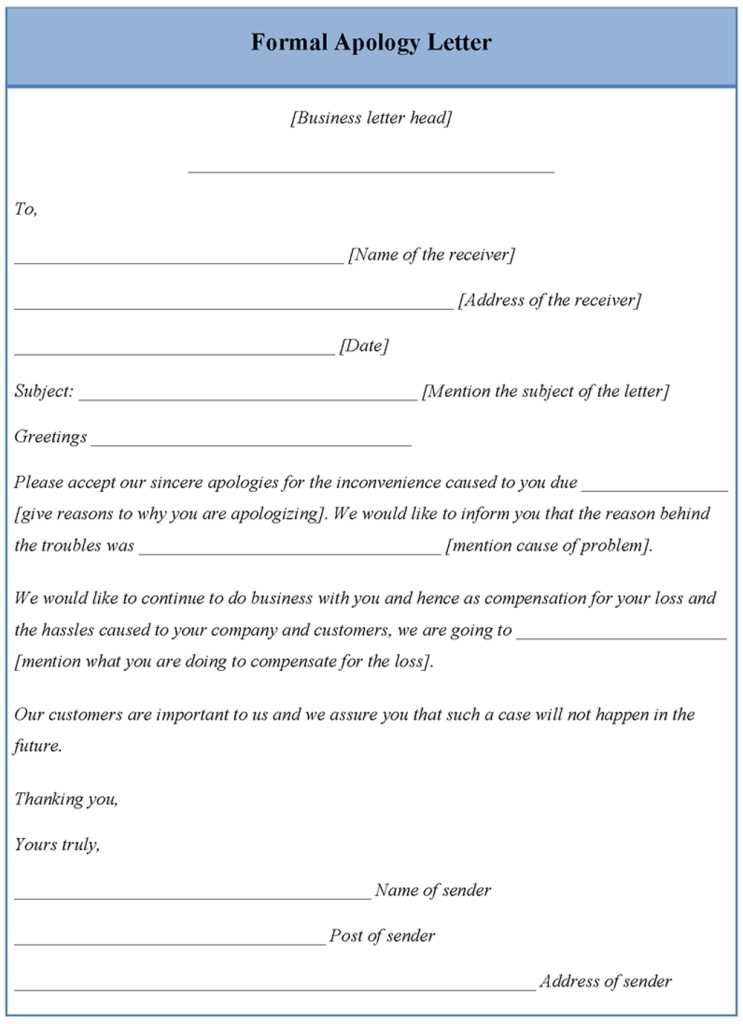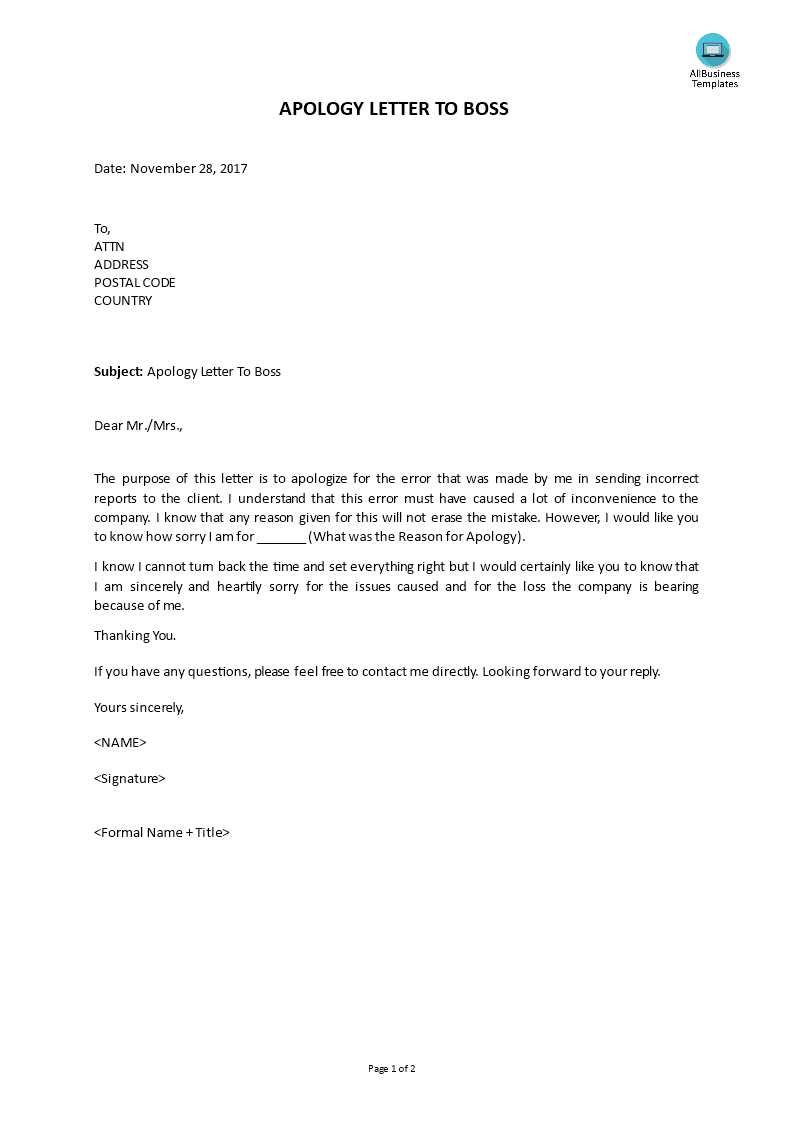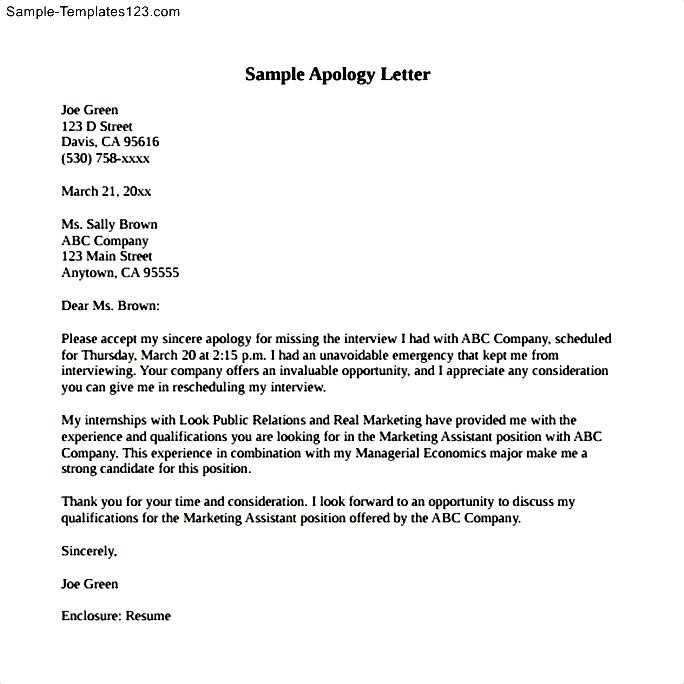Sample business apology letter template

Address the issue directly and take full responsibility for the situation. Apologize without hesitation, clearly stating the mistake or misunderstanding. Avoid shifting blame and focus on acknowledging the impact your actions may have had.
Offer a solution or an immediate plan of action to resolve the problem. This shows you’re committed to making things right and ensuring it doesn’t happen again. A brief, transparent explanation of what went wrong helps to reassure the recipient that steps are being taken to avoid recurrence.
Conclude by reaffirming your apology and expressing your commitment to maintaining a positive relationship moving forward. Keep the tone warm and professional, leaving the door open for further dialogue if necessary.
Here’s the revised version where word repetition is minimized while maintaining the meaning:
Apologies for the misunderstanding and any inconvenience it may have caused. We recognize the issue and are addressing it with priority. Our team is working diligently to ensure that similar problems do not arise again. We value your feedback and are committed to improving our services to meet your expectations.
We will keep you updated on the steps being taken to resolve the matter. Should you have any further questions, please don’t hesitate to reach out. Your satisfaction remains our priority, and we aim to make this right as quickly as possible.
Sample Business Apology Letter Template
Apologizing in business requires a clear, sincere tone and a structured approach. Address the issue directly and take responsibility without excessive elaboration.
Use this format as a guide to create an effective apology letter:
| Part | Content |
|---|---|
| Subject Line | Apology for [Issue] – [Your Company Name] |
| Salutation | Dear [Recipient’s Name], |
| Opening | We are writing to apologize for [specific issue or problem]. |
| Explanation | Unfortunately, [briefly describe what went wrong]. This caused [impact or consequence], and we understand the inconvenience it caused. |
| Responsibility | We take full responsibility for the situation and regret any frustration it may have caused. |
| Action Taken | We have already implemented the following actions to ensure this does not happen again: [briefly describe the actions]. |
| Closing | We value your relationship with us and hope to continue working together. If you have any further concerns, please do not hesitate to reach out. |
| Sign-off | Sincerely, [Your Name] [Your Position] [Company Name] |
Keep your apology direct, concise, and focused on the solution. This approach shows professionalism and respect for the recipient’s time and concerns.
- Understanding Key Elements of a Business Apology
To craft a sincere and constructive business apology, focus on these core components:
- Acknowledgment of the Issue: Address the problem directly without downplaying it. Recognize its impact on the customer or business relationship.
- Ownership: Take responsibility for the situation. Avoid blaming others or external factors, which can dilute the apology’s sincerity.
- Explanation (without Excuses): Briefly clarify what led to the mistake, but do not use it as a reason to justify the error.
- Commitment to Fix: Highlight the immediate steps you’re taking to resolve the situation and prevent it from happening again.
- Apologize Clearly: A direct, heartfelt apology demonstrates respect for the recipient’s feelings. It’s crucial to express regret without hesitation.
- Offer Compensation (If Applicable): In certain cases, offering restitution, like a refund or discount, can help rebuild trust.
How to Phrase Each Element

- Start by addressing the recipient’s frustration. For example: “We understand your dissatisfaction with…”
- Own up to the mistake with a clear statement: “This was our oversight, and we take full responsibility.”
- Explain what went wrong without shifting blame: “Due to an unexpected technical issue, the service was delayed.”
- End with a concrete plan for improvement: “We have implemented additional quality checks to prevent this from recurring.”
- Close with a concise and sincere apology: “We sincerely regret the inconvenience caused and appreciate your understanding.”
Final Thoughts
A business apology should prioritize the recipient’s experience and concerns. By following these steps, you can create a thoughtful response that fosters goodwill and strengthens professional relationships.
Adapt your apology based on the recipient’s personality and relationship with you. If they value formality, maintain a professional tone. For close colleagues or friends, a more personal approach will be better received.
Consider the Level of Impact
Gauge how much the situation affected the recipient. A minor inconvenience may warrant a brief acknowledgment, while a more significant issue requires a detailed and sincere apology. Tailor your wording to reflect the severity of the situation.
Match Their Communication Style

If the recipient is direct, be clear and to the point. If they prefer a more detailed explanation, provide context without overloading them with unnecessary information. This shows respect for their preferences and maintains the tone of the conversation.
Be Sincere and Transparent – Authenticity is key, no matter the recipient. Acknowledge the mistake, express regret, and outline steps you’re taking to prevent it from happening again. This helps rebuild trust and shows that you’re taking responsibility.
Adjusting the tone and detail of your apology can make all the difference in how it is received and how effectively you repair the relationship.
Send an apology as soon as possible after the mistake is recognized. Waiting too long can make the situation seem less urgent or sincere. Addressing the issue promptly shows responsibility and can help rebuild trust quickly.
- Within 24 Hours: Aim to send your apology within a day. This ensures the matter is addressed while it’s still fresh in the recipient’s mind.
- Right Medium: Choose the appropriate method based on the severity of the situation. For minor issues, an email or a message may be sufficient. For more significant mistakes, a phone call or a formal letter is better.
- Consider the Recipient: Understand the recipient’s expectations. Some may prefer a direct conversation, while others might appreciate a written apology first. Tailor your approach accordingly.
- Follow Up: After the initial apology, check in to confirm that the situation has been resolved and the person feels heard. A follow-up shows you care about the relationship beyond the apology itself.
Begin your apology with direct acknowledgment of the issue. Clear and specific language shows your commitment to resolving the situation. For example:
1. Acknowledge the mistake
Instead of vague terms, use phrases like:
- “I made an error with…”
- “There was an oversight in…”
- “I misunderstood…”
By being direct, you demonstrate accountability. Avoid any language that shifts the responsibility away from you.
2. Express regret clearly
State how the situation impacted the other party. This conveys empathy and understanding of their position. Some effective phrases include:
- “I’m sorry for the inconvenience caused by…”
- “I regret the confusion this has caused…”
- “Please accept my apologies for the frustration…”
These phrases convey genuine concern and make the apology feel more personal.
3. Offer a solution

Show proactive behavior by suggesting steps for fixing the issue:
- “We are taking immediate steps to address…”
- “Here’s how we plan to make it right…”
- “I will personally ensure this is corrected by…”
This ensures the recipient feels confident that the issue will be resolved and demonstrates your commitment to making improvements.
4. Avoid defensive language
Steer clear of excuses or blame-shifting. Phrases such as “It wasn’t my fault” or “I didn’t mean to” can undermine the apology. Focus instead on the actions you can take, not on justifying what went wrong.
5. Close with reassurance
End your apology by reaffirming your commitment to preventing future issues:
- “You can count on us to do better going forward…”
- “We are committed to ensuring this doesn’t happen again…”
- “I will follow up to confirm everything has been resolved…”
Example Table: Comparison of Apology Phrases
| Type of Phrase | Effective Example | Avoid |
|---|---|---|
| Acknowledgment | “I made an error with…” | “There seems to have been an issue…” |
| Regret | “I regret the inconvenience caused…” | “Sorry about that…” |
| Solution | “Here’s how we plan to fix it…” | “We’ll try to handle this in the future…” |
| Reassurance | “We are committed to making sure this doesn’t happen again…” | “We hope this doesn’t happen again…” |
Using specific and thoughtful phrases helps you communicate sincerity and a genuine willingness to make amends. Keep the tone friendly and solution-focused to ensure your apology is well-received.
Compensation can be a key element in a business apology, showing that you are willing to take responsibility and make things right. It helps rebuild trust and repair relationships with customers or partners. Offering a resolution demonstrates a commitment to resolving the issue and preventing future occurrences.
Effective Ways to Offer Compensation
- Refunds or Discounts: Offer a partial refund or discount on future purchases to acknowledge the inconvenience caused.
- Free Services or Products: Provide complimentary products or services as a gesture of goodwill.
- Replacements: If applicable, offer a replacement for faulty products or services that did not meet expectations.
Proposing a Practical Resolution
- Clear Action Plan: Outline the steps your business will take to address the issue and ensure it does not happen again.
- Timely Resolution: Commit to a timeline for resolving the issue and updating the concerned party.
- Personalized Communication: Tailor your resolution to fit the specific needs of the person or business you are addressing.
When offering compensation or resolution, it is important to act with transparency and follow through on promises to rebuild confidence in your brand or service.
1. Apology for a Delayed Delivery
If your company has failed to meet the agreed delivery time, express regret clearly and offer a solution. Acknowledge the mistake, explain the cause, and offer a resolution, such as expedited shipping or a discount on the next order.
Example:
Dear [Customer Name],
We sincerely apologize for the delay in delivering your order [Order Number]. Due to unforeseen circumstances, we were unable to meet the expected delivery date. We understand the inconvenience this has caused and are taking immediate action to ensure this doesn’t happen again. Your order is now scheduled for delivery by [New Delivery Date], and we are offering [Discount/Free Shipping] as a gesture of goodwill. Thank you for your patience and understanding.
Best regards,
[Your Name]
2. Apology for a Mistake in Billing
Billing errors can lead to frustration, but an honest apology and swift correction can maintain customer trust. Ensure to acknowledge the mistake, offer to correct it, and clarify any potential charges or refunds.
Example:
Dear [Customer Name],
We apologize for the billing mistake in your recent invoice [Invoice Number]. Upon reviewing your account, we discovered that the incorrect charge was applied. We have corrected the issue and issued a refund of [Amount]. A revised invoice has been sent to your email. Please don’t hesitate to reach out if you have any questions or need further assistance.
Sincerely,
[Your Name]
3. Apology for Poor Customer Service
When customer service falls short of expectations, a direct and personal apology is necessary. Acknowledge the specific issue and outline steps taken to improve service in the future.
Example:
Dear [Customer Name],
I want to personally apologize for the poor experience you had with our customer service team on [Date]. We strive to provide excellent service, and we clearly missed the mark in your case. We have addressed this internally and are implementing additional training to ensure this does not happen again. Thank you for your feedback and your continued support.
Best regards,
[Your Name]
4. Apology for a Canceled Event or Meeting
When an event or meeting must be canceled, promptly notify attendees and provide options for rescheduling. Offer a sincere apology and an explanation, along with any follow-up actions.
Example:
Dear [Customer Name],
We regret to inform you that due to [Reason for Cancellation], we must cancel our upcoming [Event/Meeting] scheduled for [Date]. We understand the inconvenience this may cause and would like to offer to reschedule for [New Date]. Please let us know if this works for you or if another date would be more convenient. Thank you for your understanding.
Sincerely,
[Your Name]
Steps for Crafting a Professional Apology
Begin with a clear and direct acknowledgment of the situation. Address the issue that caused the concern, and express understanding of its impact. This helps set the tone for the message and shows that you grasp the seriousness of the matter.
Take Responsibility
It’s crucial to accept full responsibility for the misstep. Avoid shifting blame or downplaying the issue. Acknowledging your role in the situation builds trust and credibility with the recipient.
Offer a Solution or Remedy
Suggest a specific course of action to resolve the situation. Whether it’s a refund, replacement, or another remedy, providing a solution demonstrates commitment to making things right and prevents the issue from recurring.
Finish by reaffirming your commitment to maintaining positive interactions and improving future communication. Reassure the recipient that the mistake will be prevented moving forward. A concise and respectful tone throughout will leave a lasting, positive impression.